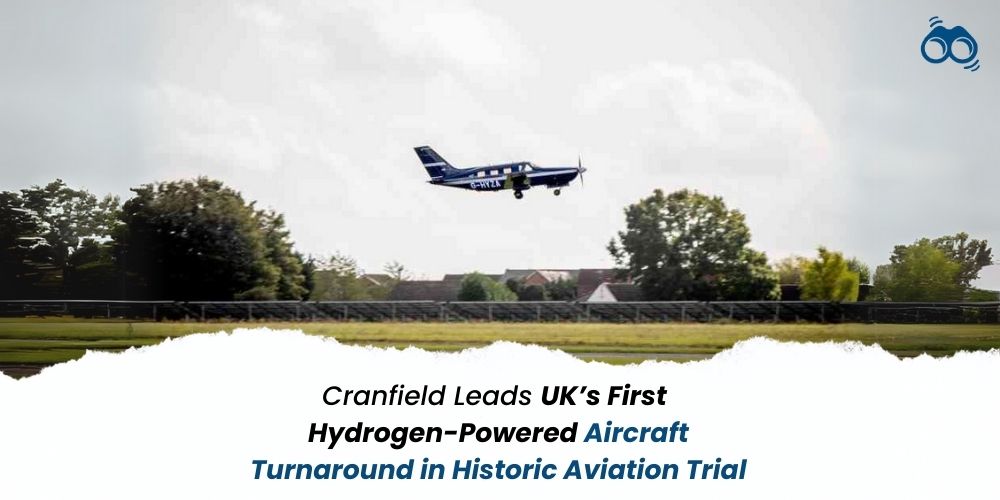Cranfield’s Breakthrough: Paving the Way for Green Aviation Technologies
Exeter Airport Hosts Landmark Hydrogen-Powered Ground Operations Trial
Airports worldwide have long been major contributors to carbon emissions, with aviation-related activities accounting for around 2.5% of global CO₂ emissions annually. A significant portion of this stems from ground operations, such as aircraft turnarounds, underscoring the urgent need for innovative, sustainable solutions. In response, Cranfield University led a pioneering initiative by conducting the world’s first hydrogen-powered turnaround of a commercial aircraft—marking a major milestone in the journey toward greener airport operations.
This landmark achievement, carried out in partnership with Exeter Airport, TUI, ULEMCo, MULAG, and Boeing, took place on April 29, 2025, at Exeter Airport. During the demonstration, a TUI Boeing 737 was serviced using a hydrogen-powered baggage tug, pushback tug, and ground power unit—all simultaneously operated and fueled by green hydrogen from renewable sources. It was the first instance in the UK—and possibly the world—where multiple hydrogen-powered systems were used in an operational aircraft turnaround.
The trial formed part of the Civil Aviation Authority’s (CAA) Hydrogen Challenge, an initiative aimed at addressing the regulatory, safety, and operational barriers to integrating hydrogen into aviation.
Professor Anna Smallwood, Head of the Centre for Air Traffic Management at Cranfield, described the project as a major step forward in safely incorporating hydrogen at airports. She highlighted Cranfield’s role in providing expertise in emissions analysis, systems integration, refuelling technologies, risk assessment, and operational analysis—key areas that will help shape future standards and innovation. Dr. Thomas Budd, Associate Professor of Airport Decarbonisation at Cranfield, noted that the live turnaround successfully demonstrated hydrogen’s short-term viability for ground operations. He stressed the importance of a holistic approach to decarbonisation, pointing out that addressing ground vehicles is just as critical as reducing aircraft emissions.
Stephen Wiltshire, Managing Director of Exeter Airport, expressed pride in hosting the demonstration. He emphasised that regional airports, likely to accommodate the first generation of hydrogen-powered aircraft, are ideal locations for such testbed initiatives. Giancarlo Buono, Group Director of Safety & Airspace Regulation at the CAA, said the trial represented a meaningful step toward adopting hydrogen as a safe, practical energy source for aviation. He praised the project for both its immediate impact in decarbonising ground operations and its contribution to shaping future regulatory frameworks.
Amanda Lyne, Managing Director of ULEMCo, highlighted the adaptability of hydrogen fuel, evidenced by the diverse technologies showcased. She pointed out that the project not only fulfilled government data requirements but also offered scalable, cost-effective solutions for decarbonisation. According to her, successful demonstrations like this reinforce the need for investment in a nationwide hydrogen refuelling infrastructure. This trial was built on previous research into turnaround emissions at Exeter Airport and was supported by the UK Government’s Regulator’s Pioneer Fund, under the Department for Science, Innovation and Technology. Overall, this initiative set a powerful precedent for integrating hydrogen into airport operations and demonstrated a viable path toward more sustainable aviation.
Editor’s Note:
Cranfield University's hydrogen-powered aircraft turnaround marks a major step toward greener aviation by demonstrating the feasibility of decarbonising airport ground operations. With aviation contributing significantly to global carbon emissions, this trial showed how hydrogen-powered equipment—baggage tugs, pushback tugs, and ground power units—can operate efficiently using renewable energy. The project, a collaboration between Cranfield, Exeter Airport, and other partners under the CAA’s Hydrogen Challenge, highlights the value of collective expertise in tackling emissions. Cranfield’s work in emissions analysis and systems integration supports the development of future industry standards and regulatory frameworks. Support from regulatory bodies and government initiatives, such as the Regulator’s Pioneer Fund, reflects a growing commitment to sustainable aviation. Amanda Lyne’s call for broader hydrogen infrastructure reinforces the importance of scalable, real-world solutions.
Skoobuzz reports that this successful demonstration establishes a compelling model for the worldwide integration of hydrogen in aviation, providing a repeatable framework for more environmentally friendly and sustainable airport operations.














0 Comments (Please Login To Continue)